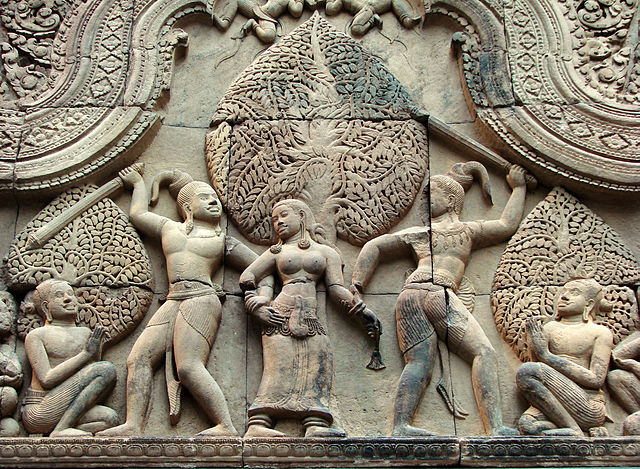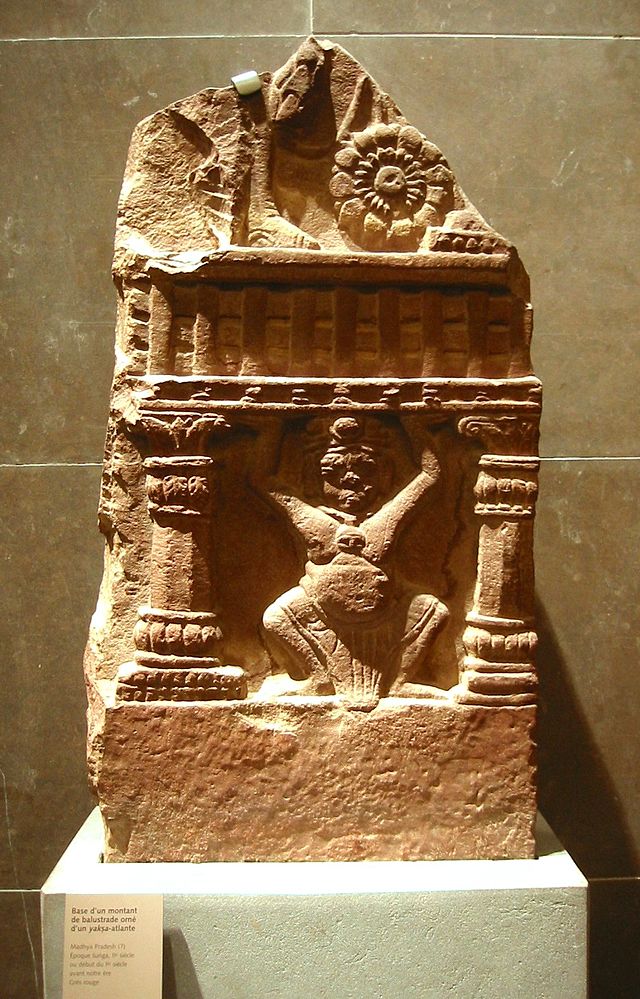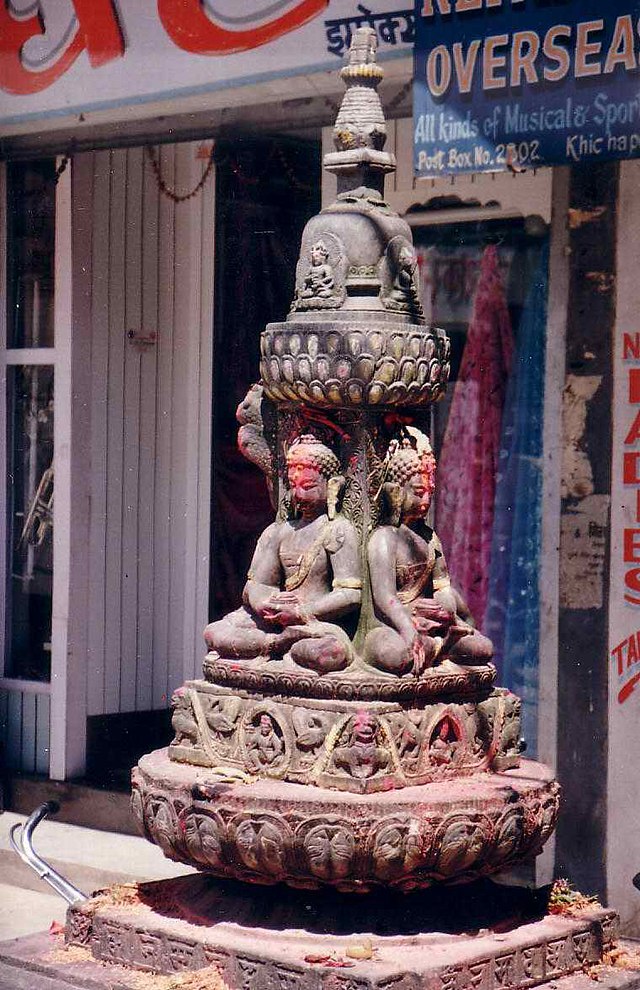亞洲藝術史
来自维基百科,自由的百科全书
亞洲藝術史或東方藝術史,包含了各類文化和宗教的廣泛影響。亞洲藝術史與西方美術史在時間上為平行發展,但大體上早上幾世紀開始出現。[1] 中國美術史、印度藝術史、[2] 韓國藝術、日本藝術[3] 都對西方藝術史有着不同程度上的影響,而相應的,西方美術對東方美術也有着不同的影響。[4]近東藝術同樣對西方藝術史有着重要的影響。[5] 除開原始藝術外,美索不達米亞藝術(現伊拉克,西南亞,約公元前7600年)代表了最古老的亞洲藝術形式。[6]

佛教藝術

佛教藝術起源於印度次大陸,並在公元前5-6世紀因釋迦牟尼迅速發展壯大,但還未接觸其他文化。而後隨着佛教在各個國家傳播,佛教藝術也隨着佛教信徒在各個國家傳播,發展和演化。佛教藝術隨着傳播分為兩支:一支向北向中亞和東亞形成北佛教藝術,另一支則向南亞發展形成南佛教藝術。在印度,佛教藝術蓬勃發展,甚至對印度教藝術產生了深遠的影響。這種影響直到公元10世紀伊斯蘭教在印度發展壯大才隨之消失。[7]
在各類精神上的傳統中,曼荼羅被求道者和行者們用來集中精神,對於他們是一種精神上的教學工具,用於創建一個「神聖的空間」,並作為冥想和出神的輔助工具。曼荼羅在象徵意義上可以幫助個人「進入更深層的無意識領域,最終幫助修禪者體驗一種由宇宙中萬物合為一體的,終極的,神秘的大統」[8] 精神分析學家卡爾·榮格將曼荼羅視為「一個無意識自我的中心的體現」,[9] 並認為曼荼羅繪畫可以幫助辨認情緒失調,並最終使該個體達到人格上的統一。 [10]
不丹藝術

不丹藝術與藏族藝術非常相似。它們都同樣基於密宗和表現(佛教)萬神殿的聖神性。[11]
不丹主要的佛教作品大都基於竹巴噶舉派和寧瑪派。前者是噶舉派的一個分支,並以其用繪畫記錄佛教大師的派別和基堪布 (不丹寺院的領導人)為世人所知。寧瑪派,其較為著名的繪畫作品蓮花生,記錄了一位於公元7世紀將佛教引入不丹的大士。神話傳說中提到,蓮花生大士為不丹未來的佛教大師,特別是白瑪林巴,將神聖的寶藏藏於不丹以供尋找。伏藏師 (佛教尋寶人)同樣也是寧瑪派藝術作品中常用的主題。
在不丹神話藝術中,每個神靈都被賦予特殊的形狀,顏色和/或相應的物體,比如蓮花,海貝殼,雷霆,乞討碗等等。每個神聖的畫像都有其特殊的規格,並在幾世紀以來一直保持不變。[12]

不丹藝術中青銅作品尤為豐富,並被稱為Kham-so (意為製作於康區),哪怕它們事實上來自整個不丹。這是因為青銅作品的製作方法最初是由藏區的東區,一個稱為康區(Kham)的地方傳來的。 該地區的壁畫和雕塑都是基於佛教藝術多年來的沉澱創作的。儘管很多藝術作品的細節都來取自藏族模型,人物和藝術作品都被大量服飾和閃閃發光的裝飾品包裹,但它們的起源很容易辨別。值得注意的是,因為惡魔世界的怪異和多樣化,藝術家們擁有相比製作神像更多的自由和發揮空間。[11]
不丹的藝術和工藝被譽為「喜馬拉雅王國的精神和身份」,並被定義為Zorig Chosum的藝術,意為「不丹的十三種工藝品」;這十三種工藝品為木工,繪畫,造紙,打鐵,縫紉,雕塑等等。位於廷布的Zorig Chosum 研究所(以及藝術學院)是由不丹政府成立的專用於研究傳統藝術與工藝的主要機構之一,目標是維護不丹豐富的文化和傳統,培養學生學習以及傳承傳統的藝術形式;還有一所類似的研究院(學院)位於不丹東部,名為Trashi Yangtse。 不丹的鄉村藝術作品大都儲存在位於廷布的『福克河提埃琪博物館』。在延布還設有「志願藝術家工作室」,用於宣傳和鼓勵延布的青少年學習藝術知識。[13][14]
柬埔寨藝術

柬埔寨藝術 以及柬埔寨的文化包括絲綢編織、銀飾、石雕、木雕、漆器、陶器、瓷器、寺廟壁畫、草編和風箏製作,有着豐富而久遠的歷史,並被印度文化深刻影響。[15]有趣的是,柬埔寨同樣深刻的影響了泰國和老撾的藝術文化。通過柬埔寨的歷史我們得知,柬埔寨藝術主要受宗教啟發。在過去的兩千年中,一些柬埔寨人從當地信仰,佛教,印度教的多重影響中發展出了一種特別的高棉族信仰,稱為泛靈論,大意為萬物皆有靈。印度文化和其文明造物,包括其語言和藝術於公元1世紀左右傳播到了東南亞區域。史學家如今達成的共識是航海商人在於印度和中國貿易時,將印度風俗和文化帶到了泰國和太平洋沿海的各個港口。第一個因此獲益的國家地區為扶南。在漫長的時間裡,柬埔寨文化也吸收了來自爪哇族,中華文化,老撾文化和泰國的文化元素。[16]

柬埔寨視覺藝術的歷史可以追溯到十幾世紀以前的古代工藝;高棉藝術在吳哥時期發展到頂峰。傳統柬埔寨藝術和手工藝包括梭織,銀器鍛造,石雕工藝,漆器,陶器, 吳哥壁畫和風箏製作。從20世紀中期開始,現代藝術的苗頭開始在柬埔寨顯現,但在20世紀後期開始衰敗。原因有許多,其中之一是紅色高棉開始殺害藝術家。[17]柬埔寨近期正在經歷由當地政府,非政府組織和來自各國的遊客支持的藝術復興。[18]
高棉雕塑指的高棉帝國的石雕,其領土範圍與如今柬埔寨相比大上很多,統治了該地區自公元9世紀至13世紀約4個世紀之久。這其中最著名的例子便是吳哥古蹟,其在當時象徵帝國的王座。
從公元7世紀開始,高棉雕塑開始擺脫印度教的影響:仿埃及前笈多王朝的佛教雕像,仿印度帕拉瓦王朝的印度雕像;並通過不斷個性化的發展演變,高棉雕塑發展出了自己的獨特風格,並在公元10世紀之前被認為已經發展完善,登峰造極了。[19]高棉雕塑的發展很快超出了宗教範圍,並開始以神仙和女神的名義為藉口雕刻宮廷人物。但同時它也是一種個性化的自我完善和發展的手段和契機,就像一種試驗場。我們可以發現,高棉王國的社會背景構成為理解和發展這門藝術提供了第二助力,但是我們也可以想象在一個更為獨特的層面上,有一小群可敬的知識分子和藝術家對這門技藝熟練掌握,提煉精粹並發揚光大。[18]

中國藝術
中國藝術與中國歷史共存共榮, 並根據中國朝代和不斷進化的科技技術歸類於不同朝代的作品。不同形式的藝術收到那時偉大的哲學家,先生,宗教形象甚至政治領導人的深刻影響。中國藝術包括純藝術,民間藝術和行為藝術三個大分類。中國藝術,無論古代還是現代,都是源於並被中國藝術家和表演者發揚光大的。[20]

在宋朝,詩歌形式被稱為詞 (文學),是一種表達個人感受,理想的詩歌形式。[21]同時在宋朝,山水畫也發展出了更為精妙的技法,畫師通過模糊山水的輪廓表現物體的遠近和深度,通過對自然景象的「印象派」處理使得作品更自然有韻味。在這個時期,繪畫相比之前更強調其中蘊含的精神而不是情感。曲是位於近代上海附近的崑山市地域,於宋代發展起來的現存最古老的戲曲形式。在元朝,由中國畫家趙孟頫所作的繪畫深刻的影響了後來的中國山水畫風格,而元朝戲曲成為了中國戲曲的變體,並發展為今天的粵劇。[22]


藏族藝術現被視為藏區的藝術作品和文化,但也可代表前喜馬拉雅山脈王國(包括不丹,拉達克,尼泊爾,和錫金)的藝術作品及文化。[23]藏族藝術的前身是一種宗教藝術,並反映了當時藏傳佛教對於藏區文化的統治力和影響力。沙壇城(藏語: kilkhor)是藏傳佛教的一種傳統的藝術形式,其在傳統上象徵了事物的短暫性。作為佛教經典的一部分,所有的事物都應該被視為短暫而易逝的。沙曼荼羅就是這個概念的一個例子,一旦這個作品製作完成,伴隨着儀式展示完畢,就會被按一定的流程摧毀。[24]
在公元前4世紀,大乘佛教第一次作為獨立的佛教流派出現,它強調了菩薩這一概念,一种放棄自我涅槃而幫助他人輪迴的存在。[25]Akira, Hirakawa (translated and edited by Paul Groner)(1993. A History of Indian Buddhism. Delhi: Motilal Banarsidass</ref>在大乘佛教早期,菩薩也是各類藝術作品,雕塑的題材。藏傳佛教作為大乘佛教的後代,也繼承了這一傳統。但是密宗(或佛教密宗)作為另一個主要流派可能在藏族藝術文化中具有壓倒其他所有流派的重要影響。藏族藝術中通常描繪的菩薩是聖觀音(Avalokitesvara),她/它/他經常被描繪成千手萬握的聖人,每隻手中間都有一隻眼睛,代表着能聆聽到我們一切請求的全知全能者。這種神聖的存在也可以理解為一個本尊,或者密宗中的「修行佛」。[26]
藏傳佛教包括了密宗佛教(Tantric Buddhism),或密宗(Vajrayana),該名詞的由來來自佛教中通用的象徵:金剛(vajra),意為「鑽石霹靂」(diamond thunderbolt,在藏語中稱為dorje)。典型的藏傳佛教藝術大部分可以看作是密宗藝術概念的一部分。密宗在傳統冥想中加入了許多可視化,想象的元素,因此大多數密宗藝術被認為是用來輔助密宗可視化冥想的工具,以及代表本尊,曼荼羅等概念和儀式的實物。[27]

在視覺上代表密宗佛教的元素一般是忿怒尊,一般由憤怒的面孔,火焰組成的圓圈或死者的頭骨組成。[28]這些圖像一般代表保護者(梵語:dharmapala,護法神),但他們猙獰的表象和舉止掩蓋了他們富有同情心的天性。事實上,他們的憤怒代表了他們對保護法 (印度哲學)及其傳承,一些特殊的密宗儀式,和防止腐敗或破壞行為的奉獻精神。他們認為在心理上,憤怒的態度可以督促密宗教徒不產生消極情緒。[29] [30]
史學家們認為中國畫對於藏區繪畫有着非常深刻的影響。從十四至十五世紀開始,西藏繪畫融入了許多中國的元素,在公元十八世紀中國繪畫對西藏視覺藝術的影響到達了一個新的高峰。[31]根據朱塞佩·特治所說,到了清朝,「一種全新的藏族藝術出現了,它在某種意義上被視為一種對中國18世紀的造作的繁榮在省級層面上所做出的回應。」[31]
印度藝術


印度藝術可以分為具體的各個時期(朝代),並能很明顯的體現其宗教,政治和文化發展元素。印度藝術最早的例子是岩刻,比如從比莫貝特卡石窟發現的作品最早可以追溯到公元前5500年。這樣的作品創作持續了足足幾千年。稍晚時期的例子有位於馬哈拉施特拉邦的埃洛拉石窟的雕柱,和阿旃陀石窟和埃洛拉石窟的濕壁畫。[32]及通用圖像藝術上[33]
特別的時期:
其中一種來自印度並廣受歡迎的藝術被稱之為藍果麗。這是一種沙畫,它用精研的白色和各色粉末製作,是一種裝飾品,在印度家庭中非常常見。[35][36]
印度的視覺藝術(雕塑,繪畫和建築)與非視覺藝術密切相關。根據Kapila Vatsyayan(印度著名藝術家)所說:「傳統印度建築,雕塑,繪畫,文學(kaavya),音樂和舞蹈都有它們自己長期發展而來的獨特規則與媒介,但它們不僅通過其內在的印度宗教哲學思想和精神信仰互相緊密關聯,並且其精神信仰和細節上的表達方式之間的聯繫也非常相似。」[37]了解印度藝術最好的方法是通過理解印度的哲學思想,泛文化和歷史,社會,宗教和政治背景而達成的。[38]
印度尼西亞藝術

印度尼西亞藝術和文化是由印度尼西亞土著藝術和多方外國文化互相影響塑造而成的。 印度尼西亞是古代遠東和中東貿易路線的核心,因此導致許多外國文化深刻的影響了印度尼西亞藝術和文化。這些外來文化包括印度教,佛教,儒家和伊斯蘭教,並在貿易城市中都非常興盛。印度尼西亞藝術文化是由複雜的多方外來文化和其土著文化混合發展出的最終結果。[39]
印度尼西亞繪畫並不聞名,但其結構複雜,富有表現力,通常表現自然景色和傳統舞蹈主題的巴厘島繪畫名聲在外。[40]

一些例外包括以南島語系為基礎的肯亞人,他們的繪畫內容基於當地的自然人文景觀,比如灌木,樹林,狗,犀鳥和人等等。在東加里曼丹省的Apo Kayan地區,Kenyah Dayak 長屋的牆上仍留有這些裝飾。[41][42]
印度尼西亞有着相對較長的一段青銅時代和鐵器時代,但在其後來的公元8-10世紀,印度尼西亞的藝術,包括獨立藝術和寺廟,或宗教藝術發展迅速,在當時尤為興盛。[43][44]

在這段時期出產的藝術品中,最值得關注的是位於爪哇島島中心婆羅浮屠廟中長達數百米的浮雕。該浮雕大約有兩英里長,描述了釋迦牟尼生活和教學的場景。[45]這片浮雕,以及寺廟中其他藝術品和寺廟本身都顯示了一定程度上的印度元素。這座廟此前供奉着504座坐姿佛像。[46][47]
印度尼西亞的書法大多數來自或基於古蘭經,這些書法很多被作為裝飾品和藝術品,因為伊斯蘭教教義禁止製作描繪自然景物的藝術品。[48]在近代以及現代,一些外來藝術家來到印度尼西亞,並持續影響着印度尼西亞的藝術風格。現代印度尼西亞的藝術家有着非常多不同的藝術風格和主題。

峇里藝術是作為印度教徒的爪哇島人所創作的藝術,起源於滿者伯夷的藝術作品,並於13世紀後期發展到巴厘島。[49] 公元16世紀到20世紀,Kamasan市的一個村莊,克隆孔(Klungkung,位於巴厘島東部),曾是古典峇里藝術的中心。在20世紀早期,各式各樣的新峇里藝術開始發展。到20世紀晚期烏布德和其相鄰的村莊開始享有「峇里藝術中心」的聲譽。烏布德和巴圖布蘭以其繪畫聞名,Mas(如今為Mas雕刻中心為一處旅遊景點)以其木雕聞名,蘇卡瓦堤(Celuk)以其金銀器鍛造聞名,蘭石雕村(或巴圖布蘭,Batubulan)以其石雕聞名。Covarrubias[50] 將峇里藝術描述為:「...一種高度發展的非正式巴洛克式民間藝術,它將農民的活力與印度教的古典主義的完美結合起來,並擺脫了傳統宗教的保守和偏見,發展出了熱帶地區獨有的惡魔般的原始粗獷」。Eiseman指出,巴厘島藝術實際上是雕刻,繪畫,編織,這類隨時能投入到日常使用的作品,,而不是「對象藝術」(意為刻意為了成為藝術品而製作的藝術)。[51]
在二十世紀二十年代,隨着許多外籍藝術家的到來,巴厘島成為了一個藝術家的聚集地。在更近紀念,一些前衛藝術家,如 沃爾特斯拜(德國),魯道夫伯尼特(荷蘭), 阿德里安·簡·勒·梅耶爾(比利時),阿里斯密特(荷蘭) and 唐納德·弗林德(澳大利亞)等等加入了這個行列。但哪怕直到二戰後,這些西方藝術家中大多數人對也巴厘島藝術和文化的影響甚微,一些報道過分強調了西方的影響而忽略了巴厘島自身的創造力。
這個創意開放的時代在二十世紀三十年代發展到達頂峰。一系列知名人物和藝術家,包括查理·卓別林,人類學家格雷戈里·貝特森和瑪格麗特·米德等,鼓勵有才華的當地人創作原創作品。格雷戈里·貝特森和瑪格麗特·米德在二十世紀三十年代中期於巴厘島逗留期間,收集了2000多幅畫作,主要來自Batuan村和沿海村莊Sanur。[52] 在西方藝術家眼中,作品中開始出現間諜(Spies)和帽子(Bonnet)一般被認為是巴厘島繪畫現代化的標誌。從20世紀50年代開始,巴厘島藝術家將這些藝術家的視角和主題結合起來,開始發展新一代巴厘島藝術。[53] 更重要的是,他們鼓勵各類藝術實驗,推動巴厘島藝術的變革,將新的巴厘島藝術與傳統的分離開來。後來的結果表明,個人思想和實驗的爆炸式增長極大的增加了巴厘島藝術的變革進程。
日本藝術

日本藝術及建築代表着從人類開始在日本島居住至今做製作的藝術品,一般來說是從公元前10世紀的某個時間點直至今天。日本藝術包括了從古代到二十一世紀的陶器,木雕,銅雕,絲綢和紙張上的水墨畫,以及其他各種風格和媒體廣泛的藝術作品。[54]
我們認知的傳統日式藝術風格及藝術形式始於十六世紀七十年代來自菱川師宣的單色藝術作品,並在十七世紀下半葉的江戶(東京)大都會文化中發展至一個高峰。[55]起初,日本藝術家只使用印度墨,用刷子給藝術品上色,直至18世紀,鈴木春信開發了多色印刷技術以用來生產「錦絵」。[56]

日式繪畫(Kaiga)是日本藝術中最古老和最精緻的作品之一,涵蓋了各種各樣風格和形式。日本的藝術和其歷史一樣,日本繪畫史就是日本本土的日式美學和外來引進思想互相適應的漫長過程。[57]
日本繪畫的起源可以追溯到日本舊石器時代。考古學家們在繩文時代的陶器和彌生時代 (公元前300年–公元300年)的銅鐸上發現了簡單的小人和幾何圖形,並古墳時代 (公元300–700年)許多墳冢中發現了壁畫上有幾何圖形和人物形象作品。[58][59]
古代 日本雕塑的主題主要來自佛教的偶像崇拜或神道神的泛靈儀式。日式雕塑主要以佛教內容為中心。傳統上使用的材料是金屬 - 尤其是青銅 - 更常見還有木頭,且通常用力架上漆,貼金,或上明亮的漆料。到江戶時代末期,因為佛教寺廟的損毀以及貴族這一概念的消失,這種傳統的雕塑 - 除了小型化的作品 - 基本上都已經消失了。[60]
浮世,意為「漂浮的世界」[61](參見浮世繪),指的是在江戶 (現東京)、 大阪市和京都市這樣的大都市中發展出來的,指代「一個自我的世界」的年輕文化。「浮世」是對同音異義語「悲哀的世界(憂き世)」的暗示諷刺,是佛教教徒精神上追求的超脫塵世,死亡和重生等概念的具象化。[62]
韓國藝術

注意:Korean Art在本條目根據地理位置(朝鮮半島)譯為韓國藝術。關於朝鮮和韓國的名稱探討請參考:朝鮮 (稱謂)。
韓國藝術中較為突出的有陶瓷,音樂,書法,繪畫,雕塑等各種流派和傳統,它們通常以大膽的色彩,自然的形式,精確的形狀和規模以及其獨特的表面裝飾為辨識標誌。[63]
儘管韓國(指朝鮮半島地區,包括現北部朝鮮),中國和日本三國的文化上有清晰的區別,但它們的藝術在歷史上和一些方面有着非常相似之處。[64]
對於朝鮮藝術的研究和欣賞在西方藝術界還處於初始階段。因朝鮮 (稱謂)在地理位置上處於中國和日本之間,韓國被認為是中國和日本文化交流的渠道。[65]然而,近年一些學者已經開始承認韓國自己獨特的藝術,文化和國家間扮演的角色:不僅傳播中國文化,且通過吸收中國文化,創造了自己獨特的文化。[66][67]
藝術史學家們通常認為朝鮮繪畫的歷史可以追溯到其第一次作為獨立藝術形式出現的時間,約公元108年。[68]遺憾的是,現在很少有關於從公元108年至高麗王朝這段時期的研究和研究資料。但如今可以肯定的是,在朝鮮王朝之前,朝鮮風景畫,肖像繪畫,佛教繪畫被中國繪畫深刻影響,並至今未能擺脫。[69]

在整個韓國繪畫史上,不但有常常被提出單獨討論的,用黑色筆墨在桑皮紙或絲綢上繪畫的作品形式;還有色彩豐富的民間藝術,或稱之為min-hwa,儀式藝術,墓碑繪畫,節日藝術等大量應用不同顏色的藝術作品。在古代朝鮮,對於顏色應用的區別是根據階級形成的:學者,尤其是儒家藝術,認為人們可以在漸變的單色繪畫(主要是黑白)中看到色彩,認為色彩的實際運用會使繪畫變得粗俗,限制了想象力。而在朝鮮民間藝術中,藝術家和工匠們會把建築的外側,木製框架的外圍漆成明亮的顏色。韓國建築同樣受到了中國傳統建築和早期色彩豐富的印度藝術的深刻影響。[70]
老撾藝術

老撾藝術 包含了老撾陶藝,老撾佛教雕塑,老撾音樂等等。[71][72]
[73]老撾的佛教雕塑創作材料種類繁多,包括金,銀和主要使用的青銅。老撾藝術家常用磚和砂漿製作巨型雕塑,其中一個比較著名的是永珍的Phya Vat (十六世紀)。木材是非常受小型供奉佛像所歡迎的製作材料,這些佛像常被擺放在各種洞穴中。一些大型等身的佛像也常用木頭製作。[74]其中最著名的兩座由次貴重寶石所雕成的雕像是玉佛(Phra Keo,現於玉佛寺 (曼谷))和法拓沁那拉佛行走銅像(Phra Phuttha Butsavarat)。[75][76]玉佛, 來自 Xieng Sen (清盛縣),是由一整塊玉石雕刻而成的。在18世紀後期,該雕像在暹羅(泰國)作為戰利品送走之前,在萬象停留了兩百年。如今它和法拓沁那拉佛行走銅像一同作為泰國王朝的palladium(希臘傳說中自天而降的雅典娜像)[77]放置在曼谷的曼谷大皇宮內。
許多美麗的老撾佛教雕像都在帕烏洞及其周邊洞穴中。在帕烏洞邊上,南烏河河口,Tham Ting (下級洞穴)和Tham Theung (上級洞穴)[78]就在老撾的琅勃拉邦市附近。這個洞穴群非常壯觀,但只能乘船抵達。它們位於距離琅勃拉邦市中心大約兩個小時船程的上游,且最近為越來越多遊客所熟知和前往遊覽。這些洞穴因其大量令人印象深刻的佛教和老撾藝術風格的雕塑被雕刻在洞穴的牆壁上而聞名,洞穴中的地面和架子上在被發現時擺放着成百上千被遺棄的佛教人物塑像。這些雕塑被擺放在這些洞穴中因為它們的擁有者不希望摧毀它們,但他們因崎嶇的山路或旅程中碰到的某些困難而不得不將一些不太重要的雕像遺留在山洞中。[79][80]
尼泊爾藝術

加德滿都文化是一個古老而精緻的文化傳承,其對於尼泊爾人而言,則意味着一個永不間斷的,由印度教和佛教忠實教徒組織的各種集會。[81][82]加德滿都的藝術和文化還包含了許多其他不同的文化,如耆那教, 伊斯蘭教和基督教藝術及文化。[83][84]
泰國藝術

泰國藝術,或泰國視覺藝術傳統上的前身是佛教藝術和皇家藝術。雕塑幾乎和佛教藝術相同,而繪畫也僅限於書籍的插畫和建築的裝飾,一般來說是宮殿和神廟等。泰國的佛教藝術來自不同的時期,包含了多種不同藝術風格。[85]當代泰國藝術通常是傳統泰國元素與現代技術相結合的產品。[86][87]
傳統泰國繪畫一般從兩個維度描繪物體,並且沒有透視投影。繪畫中各個元素的尺寸一般代表其重要程度,占地越大則越重要,反之亦然。構圖從根本上來講是合理地劃分不同視覺元素的區域,而不同的主要物體則通過空間轉換來分割獨立。這種空間轉換的方法使繪畫沒有了中間過渡部分,從而巧妙地避免了透視投影。透視投影是西方藝術圈在19世紀中期才發明出現的。[88]
泰國藝術中最常見的繪畫主題是:本生故事,釋迦牟尼的人生傳記,佛教概念中的天國和地獄,以及日常生活的場景。[89]
素可泰時期始於公元14世紀的素可泰王國。[90] 素可泰時期的佛像典雅,軀體蜿蜒且細長,大體呈橢圓形。這種風格強調了佛像的精神形態,從而忽略了解剖學上必要的細節。這種雕塑效果是通過鑄件在金屬上塑造圖案和形狀形成,而不是雕刻而成的。這段時期的佛像請參照「行走佛」的姿勢。

越南藝術
越南藝術來自東南亞最古老的文化之一,越南文化。越南擁有者豐富的藝術遺產和底蘊,可追溯到史前時代,包括絲綢繪畫,雕塑,陶器,陶瓷,版畫,建築,音樂,舞蹈,戲劇等等[98]

越南藝術是由越南當地藝術和越南藝術家創造的,其古代的東山鼓到近代越南(歷史)藝術被中國佛教文化深刻影響,其中也包括了道教和儒家的影響。占婆藝術和法國藝術在後來對越南藝術也有相對較小的影響。[99]
中國文化對越南藝術的影響非常深遠,尤其在越南陶器,書法和傳統建築上尤為明顯。現在,越南漆畫開始發展出一定的影響力。[100]
阮朝是越南最後一個朝代(c. 1802–1945),它重新開始將瓷器發揚光大。那時,亞洲各地的皇室都有進口越南的瓷器。
儘管在阮朝時期的表演藝術(如宮廷音樂和舞蹈)發展到一個新的高峰,但在阮朝後期,部分表演藝術開始衰落。
從十九世紀開始,現代藝術和法國文化開始傳入越南。20世紀初期,印度支那高等美術學院(Indochina College of Arts)成立,學院主要教授歐洲的藝術形式和技法,並在河內市和胡志明市等大城市有着相當的影響力。[101]
法國在越南長達80年的統治時間中,其對越南的旅遊限制和長期的民族獨立戰爭導致越南藝術家很少有機會到越南以外的地方學習或工作。[102][103]少數比較富裕的越南藝術家才有機會前往法國,並在那裡發展它們的職業生涯[102] 比如Le Thi Luu, Le Pho, Mai Trung Thu, Le Van De, Le Ba Dang and Pham Tang等人。[102]
近現代的越南藝術家開始利用法國的技術和絲綢,漆器等傳統媒介,開始嘗試製作融合了東西方元素的獨特藝術作品。[104]
越南書法有着悠久的歷史,該書法的前身是漢字和喃字。現在越南書法中最常用,受歡迎的是越南文字母。[105]
在過去,那些基於圖形的舊書法文字被越南上層社會,學者和精英所掌控,但這並不妨礙書法成為普通越南人生活中非常重要的一部分。在一些越南重要的節日和場合中,比如越南新年,人們會請村中的教師和學者製作書法作品,並將其掛在牆上。這些書法作品一般是詩歌,民間傳說,諺語,有時甚至有單字。一些不識字不會寫字的越南人也會讓學者替他們書寫一些禱詞,然後帶到寺廟中燒掉。[105]
中亞洲藝術
美索不達米亞藝術
猶太藝術
伊斯蘭藝術
伊朗(波斯)藝術
阿拉伯藝術
註:因阿拉伯藝術主體受伊斯蘭教影響,故
亞洲藝術作品展覽
相關條目
馬來西亞藝術家列表
參考文獻
相關書目
相關鏈接
Wikiwand - on
Seamless Wikipedia browsing. On steroids.
























